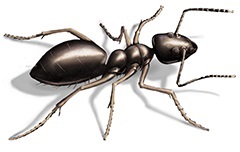Truly Green Technicians are trained to help manage Odorous Ants and similar pests. Since every building or home is different, your Truly Green Technician will design a unique ant treatment program for your situation.
Keeping ants out of homes and buildings is an ongoing process, not a one-time treatment. Truly Green ant program is a continuing cycle of three critical steps — Assess, Implement and Monitor. Truly Green Pest Service can provide the right solution to keep ants in their place...out of your home, or business.
Size: Odorous house ants, sometimes called odorous ants, are small, measuring 2.4 to 3.3 mm in length.
Color: They have dark brown or black bodies with one node on their petiole, which is hidden by their abdomens.
Shape: Odorous house ants have an unevenly shaped thorax when viewed from the side.
Smell: The most distinguishable characteristic of odorous house ants is the smell of rotten coconut that is emitted when their bodies are crushed.

Odorous house ants are opportunists, nesting both indoors and outdoors. Nests are found in a great variety of situations. Indoors, odorous ants can nest in wall crevices, near heaters, water pipes, under carpets, beneath floors or sometimes behind paneling. They are most likely to invade buildings during rainy weather. Odorous ants travel in trails, foraging day and night. Outdoors, odorous house ants place their shallow nests beneath soil as well as in logs, mulch, debris and under rocks
Odorous house ants forage for food night and day. Outdoors they prefer honeydew from aphids and mealybugs. When the honeydew supply is reduced in autumn, they may move indoors for food. Indoors, they eat meats, sugary foods, dairy products, pastries, cooked or raw vegetables and fruit juices.When alarmed by a predator, worker odorous ants will move in quick, erratic motions, raising their abdomens into the air.
created with
Joomla Website Builder .